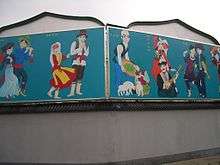Kyrgyz in China

The Kyrgyz form one of the 56 ethnic groups officially recognized by the People's Republic of China. There are more than 145,000 Kyrgyz in China. They are known in China as Kēěrkèzī zú (simplified Chinese: 柯尔克孜族; traditional Chinese: 柯爾克孜族).
Kyrgyz leaders requested Qing officials to grant them titles and honors.[1]
In the 19th century, Russian settlers on traditional Kirghiz land drove a lot of the Kirghiz over the border to China, causing their population to increase in China.[2] Compared to Russian controlled areas, more benefits were given to the Muslim Kirghiz on the Chinese controlled areas. Russian settlers fought against the Muslim nomadic Kirghiz, which led the Russians to believe that the Kirghiz would be a liability in any conflict against China. The Muslim Kirghiz were sure that in an upcoming war, that China would defeat Russia.[3]
To escape Russians slaughtering them in 1916, Kyrgyz escaped in the "Urkun" mass flight to China.[4]
The Kirghiz of Xinjiang revolted in the 1932 Kirghiz rebellion, and also participated in the Battle of Kashgar (1933), and the Battle of Kashgar (1934).
They are found mainly in the Kizilsu Kirghiz Autonomous Prefecture in the southwestern part of the Xinjiang Uygur Autonomous Region, with a smaller remainder found in the neighboring Wushi (Uqturpan), Aksu, Shache (Yarkand), Yingisar, Taxkorgan and Pishan (Guma), and in Tekes, Zhaosu (Monggolkure), Emin (Dorbiljin), Bole (Bortala), Jinghev (Jing) and Gongliu County in northern Xinjiang.[5]
A peculiar group, also included under the "Kyrgyz nationality" by the PRC official classification, are the so-called "Fuyu Kyrgyz". It is a group of several hundred Yenisei Kirghiz (Khakas people)[6] people whose forefathers were relocated from the Yenisei river region to Dzungaria by the Dzungar Khanate in the 17th century, and upon defeat of the Dzungars by the Qing dynasty, were relocated from Dzungaria to Manchuria in the 18th century, and who now live in Wujiazi Village in Fuyu County, Heilongjiang Province. Their language (the "Fuyü Gïrgïs dialect") is related to the Khakas language.
Certain segments of the Kyrgyz in China are followers of Tibetan Buddhism.[7][8][9][10][11][12] However, a large amount of Kyrgyz in China also follow Islam due to their historic Turkic background.
See also
References
- ↑ Henry Luce Foundation Professor of East Asian Studies Nicola Di Cosmo; Nicola Di Cosmo; Don J Wyatt (16 August 2005). Political Frontiers, Ethnic Boundaries and Human Geographies in Chinese History. Routledge. pp. 362–. ISBN 978-1-135-79095-0.
- ↑ Alexander Douglas Mitchell Carruthers, Jack Humphrey Miller (1914). Unknown Mongolia: a record of travel and exploration in north-west Mongolia and Dzungaria, Volume 2. Lippincott. p. 345. Retrieved 2011-05-29.
- ↑ Alex Marshall (22 November 2006). The Russian General Staff and Asia, 1860-1917. Routledge. pp. 85–. ISBN 978-1-134-25379-1.
- ↑ Sydykova, Zamira (20 January 2016). "Commemorating the 1916 Massacres in Kyrgyzstan? Russia Sees a Western Plot". The Central Asia-Caucasus Analyst.
- ↑ "The Kyrgyz – Children of Manas. Кыргыздар – Манастын балдары". Petr Kokaisl, Pavla Kokaislova (2009). pp.173–191. ISBN 80-254-6365-6
- ↑ Giovanni Stary; Alessandra Pozzi; Juha Antero Janhunen; Michael Weiers (2006). Tumen Jalafun Jecen Aku: Manchu Studies in Honour of Giovanni Stary. Otto Harrassowitz Verlag. pp. 112–. ISBN 978-3-447-05378-5. Cite uses deprecated parameter
|coauthors=(help) - ↑ Mitchell, Laurence, p. 25
- ↑ West, Barbara A., p. 441
- ↑ 柯尔克孜族. China.com.cn (in Chinese). Retrieved 2007-02-18.
- ↑ "The Kyrgyz – Children of Manas. Кыргыздар – Манастын балдары". Petr Kokaisl, Pavla Kokaislova (2009). p.4. ISBN 80-254-6365-6
- ↑ "The Kyrgyz – Children of Manas. Кыргыздар – Манастын балдары". Petr Kokaisl, Pavla Kokaislova (2009). pp.185–188. ISBN 80-254-6365-6
- ↑ "The Kyrgyz – Children of Manas. Кыргыздар – Манастын балдары". Petr Kokaisl, Pavla Kokaislova (2009). pp.259–260. ISBN 80-254-6365-6
External links
Photo album of Chinese Kyrgyz, 2007 (Website of Central Asia) from Petr Kokaisl, www.central-asia.su
